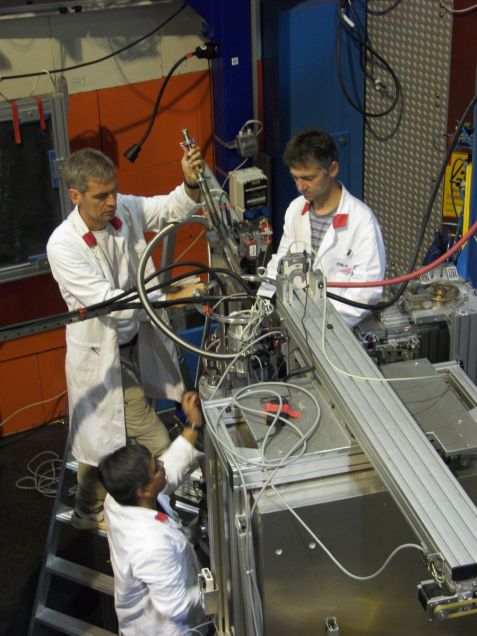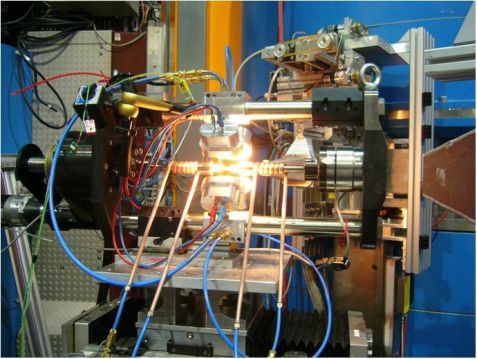MLZ is a cooperation between:
 > Technische Universität München
> Technische Universität München > Helmholtz-Zentrum Hereon
> Helmholtz-Zentrum Hereon
 > Forschungszentrum Jülich
> Forschungszentrum Jülich
MLZ is a member of:
 > LENS
> LENS > ERF-AISBL
> ERF-AISBL
MLZ on social media:

MLZ (eng)
Lichtenbergstr.1
85748 Garching
Neutron probes provide vital input in the development of Co-Re alloys for future gas turbines

Sample change at the high-temperature furnace performed by Ralph Gilles (TU München), Pavel Strunz (NPI Rez near Prague) and Debashis Mukherji (TU Braunschweig).
Today, nickel (Ni) superalloys are the most dominant materials in gas turbines used for power generation and in airplanes. However, to increase efficiency, the gas turbine manufacturers plan in future to increase the temperature of the gas inside turbines, to the extent that Ni-superalloys cannot perform well enough to meet this demand. Researchers at the Braunschweig University of Technology (TU Braunschweig,Institute for Materials) try to address this challenge by developing new Co-Re-based high temperature alloys for these ultra-high temperature applications [1]. Neutron scattering reveals important information about the changes in the crystal lattice of superalloys during the heating and deformation of the material, and in thicker specimens it can provide information on internal stress distribution. For the non-destructive study of such materials, neutrons are therefore indispensable.
Design and optimization of the alloys
Co-based alloys are not new and are presently used in gas turbines for static components up to 1000°C. The refractory metal rhenium (Re) has the third highest melting temperature (3186°C) in the periodic table – more than double that of Co (1495°C) and Ni (1455°C). The addition of Re to Co increases the melting point of Co alloys, thus making it significantly higher than that of Ni superalloys. Other elements such as Cr, Si, Ta, C, etc. are added to Co-Re alloys, either to increase strength or oxidation resistance at high temperatures. These additions also make the microstructure of Co-Re-base alloys very complex. The design and optimization of the alloy microstructure is an important first step in alloy development.
Neutron scattering at STRESS-SPEC and SPODI
Strength and long term stability of the Co-Re alloys at the correct application temperature (> 1200°C) is critical and here in-situ measurements with neutron probes play a vital role in Co-Re alloy development. The scientists from TU Braunschweig and TUM are working together on these measurements and the results obtained are being used to guide the alloy design at Braunschweig. The test stand (Fig. 1) for the neutron source is situated at Garching and measurements with neutrons were performed using the instruments STRESS-SPEC and SPODI at FRM II, thereby providing vital input for the development of the alloy [2, 3]. Soon the new Small-Angle Scattering Instrument SANS-1 will be included in studies on the characterization of particle size and the morphology of precipitates.
High temperature furnace at STRESS-SPEC

The installed tensile rig with the high-temperature equipment including four heat lamps at the neutron diffractometer STRESS-SPEC at the MLZ. The heating shield is dismounted to provide an insight into the setup.
A high temperature furnace using a light source for heating was specifically developed for the tensile rig at the STRESS-SPEC instrument to perform simultaneous heating and deformation experiments in a neutron beam, thereby monitoring the structural changes and the evolution of the microstructure at high temperatures (up to 1000°C) with the neutron probe. In particular, the new tensile rig (Fig. 2) will allow in situ measurements at high temperatures to be made, under the influence of loading which accurately reflects the conditions of real turbine materials in service. The high penetration depth achieved by neutrons as compared to X-rays allows the use of bulk specimens for critical tests.
Research group working on the development of Co-Re alloys
Research on the development of Co-Re alloys started in 2007 within a research group program “Beyond Ni-base Superalloys” funded by the German Research Foundation (DFG) which involved 4 other German universities, namely, the TU Darmstadt, the University of Bayreuth, Ruhr University Bochum and the University of Siegen. The Technical University of Munich (TUM) is an important co-operation partner in the Co-Re alloy development project and provides neutron beam times for critical measurements at high temperatures. A lot of interest has already been shown in Co-Re alloy development worldwide, in particular from gas turbine manufactures, such as Siemens and Alstom.
Original publication
[1] Rösler et al., Co-Re-based Alloys: A New Class of High Temperature Materials? (DOI: 10.1002/adem.200700132)
[2] Mukherji et al., The Hexagonal Close-Packed (HCP) ⇆ Face-Centered Cubic (FCC) Transition in Co-Re-Based Experimental Alloys Investigated by Neutron Scattering (DOI: 10.1007/s11661-011-1058-4)
[3] Gilles et al., Stability of phases at high temperatures in CoRe based alloys being developed for ultra-high temperature applications (DOI: 10.1088/1742-6596/340/1/012052)
MLZ is a cooperation between:
 > Technische Universität München
> Technische Universität München > Helmholtz-Zentrum Hereon
> Helmholtz-Zentrum Hereon
 > Forschungszentrum Jülich
> Forschungszentrum Jülich
MLZ is a member of:
 > LENS
> LENS > ERF-AISBL
> ERF-AISBL
MLZ on social media:



